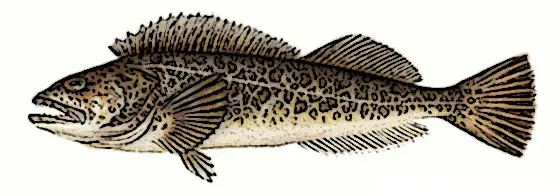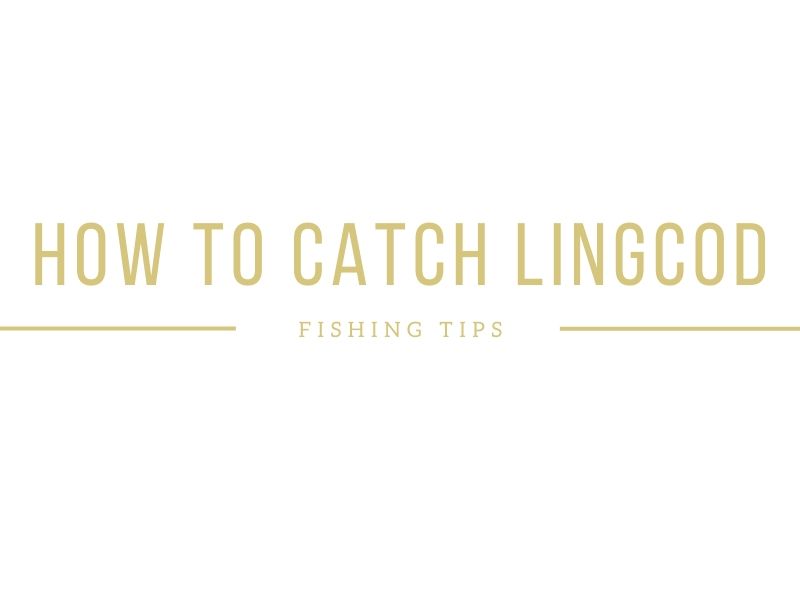Lingcod sometimes called buffalo cod or cultus cod is a fish found throughout North America on the West Coast. They are found from Mexico to California, and even in parts of Mexico. They are very popular to eat, which makes them all the more exciting to catch.
If you’re fishing for lingcod, you need to read this guide. Here we will cover how to identify them, where to catch them, their seasonal patterns, the equipment you will need, and give you a few tips to help you catch more lingcod
Lingcod Identification
Lingcod have brown, dark gray or green colored backs with copper-toned mottling or spots on the upper back. They typically have large heads and mouths with big sharp teeth and long bodies that grow more narrow towards the tail.

Most lingcod that you catch will be around 8 to 17 lbs with lengths around 20 to 30 inches. On the upper end though, lingcod can grow to huge sizes. The world record lingcod measured a whopping 55 inches in length and 82.6 pounds.
Where to Catch Lingcod
Lingcod are native to the West Coast United States where they can be fished from Alaska all the way down to California. They are generally found near the bottom in rocky areas in depths ranging from 32 feet deep to 320 feet deep.
Look for areas with a lot of rocks, boulders, cliffs, and crevices. The lingcod are likely to be lurking near these structure waiting to ambush their food. Most anglers will use their GPS when fishing for lingcod and mark any areas that they are having success at.
What Do Lingcod Eat?
Lingcod are known to eat pretty much anything and everything they can. They commonly eat a wide variety of invertebrates and fish species like salmon, rockfish, herring, Pacific hake, small octopuses and more.
Lingcod Seasonal Patterns
Lingcod are known as a non-migratory species that tend to stay in local areas, though they do more around a little bit during spawning season. In the fall months around October, lingcod will move from their rocky areas to find nearshore spawning sites. They usually look for areas with fairly strong currents and rocky ledges or crevices.
They generally spawn in later Winter, but this can take place between December and March depending on the water temperature and area. After the spawning takes place the females will leave and the males will guard the nests. The males are known to attack anything in the water at this time.
Best Time to Catch Lingcod
Lingcod seem to bite pretty consistently no matter what time it is. The weather, wind and current will affect how heavily the bite more than the time of day. Usually, the ideal conditions take place in the early morning up to 10 am though.
As far as the best season to catch them, generally, if you fish the spawning season around December to March you can have a lot of success. Be sure to look for these rocky spawning sites where the males will attack anything placed in the water.
Lingcod Tackle Recommendations
Rods and Reels
The best kind of rod for fishing lingcod will depend on the depth you are fishing. They can be caught with a wide range of tackle depending on the area. You will probably want a different rod for fishing shallower waters than the one you use for deepwater fishing.
Spinning rods are good for lighter swimbaits and shallower waters. They are easier to use and work well in a lot of situations. You can use something around 6-7’ in length with medium action.
If you’re fishing deeper waters you probably will need a baitcasting rod. Again, something around 7 feet with medium action should get the job done.
Many anglers also opt to use saltwater jigging rods for catching lingcod. Popular brands include Shimano Trevala Jigging Rods and Ugly Stik Tiger Jigging Rods.
Lures and Baits
Swimbaits
For fishing lingcod, swim baits tend to work quite well. Try to use a swimbait that matches what the lingcod are already eating. You will have to use a big swimbait and cast it into the strike zone. Generally, for lingcod this means fishing the bottom. Stay close to the bottom and you will get bites. You may need to use a leadhead along with your swimbait.
Jigs
Using a good jig lure is a great option for lingcod. Lingcod seem to be caught best on shiny jigs that are bounced along the bottom. Just make sure you use a jig that won’t snag on the bottom, or you won’t have very much fun.
Live Bait and Dead Bait
Sometimes live bait tends to work best, but you can also get away with dead bait. Anchovies, baby rockfish, mackerel, squid, and herring are all good options for lingcod. Use a weight if needed to help get your bait to the bottom. When you feel your bait hit the bottom, reel it up a bit so it stays just off the floor.
Fishing Line
For fishing deeper waters off the bottom, you will want a good braided fishing line. Something around 30-40 lb test will give you a good blend of jigging and casting and have good sensitivity for a good hookset.
If you’re fishing shallower waters you can get away with a 15-25 lbs mono line. You can also use a 25lb test fluorocarbon line. 2 to 3 feet should do the job.
Hooks
A size 8/0 to 14/0 circle hook can work well for lingcod. If you’re going to be jigging the bottom treble hooks are better options, but they can have snagging problems. A stinger hook can help you avoid snags when fishing the bottom.
Tips to Catch More Lingcod
Fish the Bottom
I know we have stated this already, but it bears repeating. Lingcod tend to stay near the rocks on the bottom. So you need to place your bait down to their level. Usually, you want to let your presentation hit the bottom and then reel it up slightly so it’s floating just off the bottom. This will get you the most bites.
Go Deep for Larger Lingcod
If you’re after a trophy-sized lingcod you want to go deep to find the larger female fish. You can find them at depths of 150 feet and below. Just make sure you have a weight heavy enough to help you get to this depth.
Use the Jigging Technique
Vertical jigging can be deadly for targeting lingcod. Often its the up and down jigging movement that gets the attention of the fish in the ocean. Try jigging your lure up and down in about 4-foot increments. Do not stop jigging. As you drift your lure over the hotspot where the fish are, you have to be in constant movement if you really want to trigger a strike. Jigging is one of the best tactics for deepwater fishing lings from your boat.
Use Gentler Hook Sets
Many times when a lingcod attacks your bait it may end up with the whole thing in its mouth. Your hook will be through your bait so any violent or jerking hook sets is likely to spook the lingcod and it will spit out your hook. Instead of a thrashing hook set, don’t get too excited and use a slower steady retrieve to set your hook.
Related Posts:
Rockfish Fishing Tips
Crappie Fishing Tips
